Entomological Evidence Reveals Burial Practices of Three Mummified Bodies Preserved in Northeast Italy
Abstract
1. Introduction
2. Materials and Methods
3. Results and Discussion
3.1. The Entomofauna Associated with Corona Hermits
3.1.1. Diptera
3.1.2. Coleoptera
3.1.3. Lepidoptera
3.2. Comparison of the Colonization of the Bodies
3.3. Clothes and Skin Analyses and Evaluations
4. Conclusions
Author Contributions
Funding
Data Availability Statement
Acknowledgments
Conflicts of Interest
References
- Erickson, J.M. Fossil oribatid mites as tools for Quaternary paleoecologists: Preservation quality, quantities, and taphonomy. Bull. Buffalo Soc. Nat. Sci. 1988, 33, 207–226. [Google Scholar]
- Buckland, P.C. The use of insect remains in the interpretation of archaeological environments. In Geoarchaeology: Earth Science and the Past; Davidson, D.A., Shackley, M.L., Eds.; West View Press: Boulder, CO, USA, 1976; pp. 369–396. [Google Scholar]
- Buckland, P.; Wagner, P. Is there an insect signal for the” Little Ice Age”? Clim. Change 2001, 48, 137–149. [Google Scholar] [CrossRef]
- Huchet, J.B. L’Archéoentomologie funéraire: Une approche originale dans l’interprétation des sépultures. Bull. Mem. Soc. Anthropol. Paris 1996, 3–4, 299–311. [Google Scholar] [CrossRef]
- Kenward, H.K. The analysis of archaeological insect assemblages: A new approach. In Archaeology of York; Council for British Archaeology for York Archaeological Trust: York, UK, 1978; Volume 19/1. [Google Scholar]
- Bain, A. Archaeoentomological and Archaeoparasitological Reconstructions at Îlot Hunt (CeEt-110): New Perspectives in Historical Archaeology (1850–1900). Ph.D. Thesis, Laval University, Quebec, QC, Canada, 1999. [Google Scholar]
- Buckland, P.I.; Buckland, P.C.; Olsson, F. Paleoentomology: Insects and other arthropods in environmental archaeology. In Encyclopedia of Global Archaeology; Smith, C., Ed.; Springer: New York, NY, USA, 2014. [Google Scholar]
- Forbes, V.; Dussault, F.; Bain, A. Contributions of ectoparasite studies in archaeology with two examples from the North Atlantic region. Int. J. Paleopathol. 2013, 3, 158–164. [Google Scholar] [CrossRef] [PubMed]
- Huchet, J.B. L’archéoentomologie funéraire (chap. 15). In Insectes, Cadavres et Scènes de Crime, Principes et Applications de L’entomologie Médico-Légale; Charabidze, D., Gosselin, M., Eds.; Editions De Boeck: Bruxelles, Belgium, 2014; pp. 201–224. [Google Scholar]
- Giordani, G.; Tuccia, F.; Floris, I.; Vanin, S. First record of Phormia regina (Meigen, 1826) (Diptera: Calliphoridae) from mummies at the Sant’Antonio abate Cathedral of Castelsardo, Sardinia, Italy. PeerJ 2018, 6, e4176. [Google Scholar] [CrossRef]
- Magni, P.A.; Harvey, A.D.; Guareschi, E.E. Insects Associated with Ancient Human Remains: How Archaeoentomology Can Provide Additional Information in Archaeological Studies. Heritage 2023, 6, 435–465. [Google Scholar] [CrossRef]
- Tuccia, F.; Giordani, G.; Vanin, S. State of the art of the funerary archaeoentomological investigations in Italy. Archaeol. Anthropol. Sci. 2022, 14, 70. [Google Scholar] [CrossRef]
- Giordani, G.; Erauw, C.; Eeckhout, P.A.; Owens, L.S.; Vanin, S. Patterns of camelid sacrifice at the site of Pachacamac, Peruvian Central Coast, during the Late Intermediate Period (AD1000–1470): Perspectives from funerary archaeoentomology. J. Archaeol. Sci. 2020, 114, 105065. [Google Scholar] [CrossRef]
- Huchet, J.B.; Greenberg, B. Flies, Mochicas and burial practices: A case study from Huaca de la Luna, Peru. J. Archaeol. Sci. 2010, 37, 2846–2856. [Google Scholar] [CrossRef]
- Vanin, S. When Entomological studies meet Archaeology: Archaeoentomology an old, new discipline for investigation of the Past. JBR 2023, 1, e2023007. [Google Scholar]
- Vanin, S.; Turchetto, M.; Galassi, A.; Cattaneo, C. Forensic Entomology and Archaeology of War. J. Confl. Archaeol. 2010, 50, 127–139. [Google Scholar] [CrossRef]
- Pradelli, J.; Rossetti, C.; Tuccia, F.; Giordani, G.; Licata, M.; Birkhoff, J.M.; Verzeletti, A.; Vanin, S. Environmental necrophagous fauna selection in a funerary hypogeal context: The putridarium of the Franciscan monastery of Azzio (Northern Italy). J. Archaeol. Sci. Rep. 2019, 24, 683–692. [Google Scholar] [CrossRef]
- Vanin, S.; Tuccia, F.; Pradelli, J.; Carta, G.; Giordani, G. Identification of Diptera Puparia in Forensic and Archeo-Funerary Contexts. Insects 2024, 15, 599. [Google Scholar] [CrossRef]
- Huchet, J.-B.; Le Mort, F.; Rabinovich, R.; Blau, S.; Coqueugniot, H.; Arensburg, B. Identification of dermestid pupal chambers on Southern Levant human bones: Inference for reconstruction of Middle Bronze Age mortuary practices. J. Archaeol. Sci. 2013, 40, 3793–3803. [Google Scholar] [CrossRef]
- Wrobel, G.D.; Biggs, J. Osteophageous insect damage on human bone from Je’reftheel, a Maya mortuary cave site in west-central Belize. Int. J. Osteoarchaeol. 2018, 28, 745–756. [Google Scholar] [CrossRef]
- Thompson, J.E.; Martín-Vega, D.; Buck, L.T.; Power, R.K.; Stoddart, S.; Malone, C. Identification of dermestid beetle modification on Neolithic Maltese human bone: Implications for funerary practices at the Xemxija tombs. J. Archaeol. Sci. Rep. 2018, 22, 123–131. [Google Scholar] [CrossRef]
- Britt, B.B.; Scheetz, R.D.; Dangerfield, A. A Suite of Dermestid Beetle Traces on Dinosaur Bone from the Upper Jurassic Morrison Formation, Wyoming, USA. Ichnos 2008, 15, 59–71. [Google Scholar] [CrossRef]
- Loni, A.; Vanin, S.; Fornaciari, A.; Tomei, P.E.; Giuffra, V.; Benelli, G. Back to the Middle Ages: Entomological and Botanical Elements Reveal New Aspects of the Burial of Saint Davino of Armenia. Insects 2022, 13, 1113. [Google Scholar] [CrossRef] [PubMed]
- Vanin, S.; Boano, R.; Giordani, G.; Carta, G.; Fulcheri, E. Description of the entomofauna associated with the remains of the Cistercian nun Angela Veronica Bava (1591–1637). Med. Histor. 2022, 6, e2022006. [Google Scholar]
- Zangheri, S.; Fontana, P. Indagini sugli insetti rinvenuti nella bara attribuita a San Luca Evangelista. In San Luca Evangelista Testimone della Fede che Unisce. Atti del Congresso Internazionale, Padova, 16–21 Ottobre 2000, I Risultati Scientifici sulla Ricognizione delle Reliquie Attribuite a san Luca. Fonti e Ricerche di Storia Ecclesiatica Padovana; Terribile Wiel Marin, V., Trolese, F.G.B., Eds.; Istituto di Storia Ecclesiastica Padovana: Padova, Italia, 2003; Volume 2. [Google Scholar]
- Larentis, O.; Gorini, I.; Campus, M.; Lorenzetti, M.; Mansueto, G.; Bortolotto, S.; Zappa, E.; Gregorini, A.; Rampazzi, L.; Vanin, S.; et al. Integrated multidisciplinary analysis of mobile digital radiographic acquisitions of the mummies of the Hermits from the Sanctuary of Madonna della Corona (Trentino-Alto Adige, Italy-17th to 19th Century CE). Front. Med. 2025, 11, 1492328. [Google Scholar] [CrossRef]
- Vanin, S.; Giordani, G.; Carta, G. From the field to the microscope: Funerary archaeoentomology workflow. JBR 2023, 1, 2023017. [Google Scholar]
- Giordani, G.; Grzywacz, A.; Vanin, S. Characterization and identification of puparia of Hydrotaea Robineau-Desvoidy, 1830 (Diptera: Muscidae) from forensic and archaeological contexts. J. Med. Entomol. 2019, 56, 45–54. [Google Scholar] [CrossRef]
- Giordani, G.; Vanin, S. Morphological characterization of puparia and molecular analysis of Heleomyza serrata (Linnaeus, 1758) (Diptera: Heleomyzidae): A species of potential forensic interest. Eur. Zool. J. 2023, 90, 604–613. [Google Scholar] [CrossRef]
- Rozkosny, R.; Gregor, F.; Pont, A.C. The European Fanniidae (Diptera); Institute of Landscape Ecology: Brno, Czech Republic, 1997. [Google Scholar]
- Lyneborg, L. Taxonomy of European Fannia larvae (Diptera, Fanniidae); Staatliches Museum für Naturkunde: Karlsruhe, Germany, 1970. [Google Scholar]
- Skidmore, P. The Biology of the Muscidae of the World; Springer Netherlands: Dordrecht, The Netherlands, 1985. [Google Scholar]
- Smith, K.G.V. A Manual of Forensic Entomology; London Trustees of the British Museum: London, UK, 1986. [Google Scholar]
- Szpila, K. Key for the identification of third instars of European blowflies (Diptera: Calliphoridae) of forensic importance. In Current Concepts in Forensic Entomology; Amendt, J., Goff, M.L., Campobasso, P.C., Grassberger, M., Eds.; Springer Verlag: Dordrecht, The Netherlands, 2010; pp. 43–56. [Google Scholar]
- Vienna, P. Histeridae. Fauna d’Italia Vol. XVI; Edizioni Calderini: Bologna, Italy, 1980; 386p. [Google Scholar]
- Zahradaník, P. Beetles of the Family Ptinidae of Central Europe/Brouci Čeledi Červotočovití (Ptinidae) Střední Evropy; Zoological Keys/Zoologické Klíče, Vol. 2; Academia Press: Gand, Belgium, 2013. [Google Scholar]
- Háva, J. Beetles of the Family Dermestidae of the Czech and Slovak Republics; Academia: Praha, Czech Republic, 2021. [Google Scholar]
- Vanin, S.; Gherardi, M.; Bugelli, V.; Di Paolo, M. Insects found on a human cadaver in central Italy including the blowfly Calliphora loewi (Diptera, Calliphoridae), a new species of forensic interest. Forensic Sci. Int. 2011, 207, e30–e33. [Google Scholar] [CrossRef] [PubMed]
- Vanin, S.; Tasinato, P.; Ducolin, G.; Terranova, C.; Zancaner, S.; Montisci, M.; Ferrara, P.; Turchetto, M. Use of Lucilia species (Diptera: Calliphoridae) for forensic investigations in Southern Europe. Forensic Sci. Int. 2008, 177, 37–41. [Google Scholar] [CrossRef]
- Henríquez-Valido, P.; Santana, J.; Morquecho-Izquier, A.; Rodríguez-Rodríguez, A.; Huchet, J.-B. Insects in the far West: Burial practices on El Hierro Island (Canary Islands, Spain; ca. 6th-11th centuries) reconstructed via funerary archaeoentomology. J. Arch. Sci. 2025, 173, 106120. [Google Scholar]
- Pérez-Marcos, M.; García, M.D.; López-Gallego, E.; Ramírez-Soria, M.J.; Arnaldos, M.I. Life Cycle and Biometric Study of Hydrotaea capensis (Wiedemann, 1818) (Diptera, Muscidae), a Species of Forensic Interest. Insects 2022, 13, 531. [Google Scholar] [CrossRef]
- Loni, A.; Fornaciari, A.; Canale, A.; Giuffra, V.; Vanin, S.; Benelli, G. Insights on funeral practices and insects associated with the tombs of King Ferrante II d’Aragona and other Renaissance nobles. J. Med. Entomol. 2019, 56, 1582–1589. [Google Scholar] [CrossRef]
- Lunardini, A.; Carta, C.; Costantini, L.; Minozzi, S.; Giuffra, V.; Giordani, G.; Vanin, S. Entomological analysis for archaeological reconstruction and conservation strategies design: The mummies of Cerreto di Spoleto (Central Italy). Archaeol. Anthrop Sci. 2023, 15, 149. [Google Scholar] [CrossRef]
- Reibe, S.; Madea, B. Use of Megaselia scalaris (Diptera: Phoridae) for post-mortem interval estimation indoors. Parasitol. Res. 2010, 106, 637–640. [Google Scholar] [CrossRef] [PubMed]
- Sessa, F.; Varotto, E.; Salerno, M.; Vanin, S.; Bertozzi, G.; Galassi, F.M.; Maglietta, F.; Salerno, M.; Tuccia, F.; Pomara, C.; et al. First report of Heleomyzidae (Diptera) recovered from the inner cavity of an intact human femur. J. Forensic Leg. Med. 2019, 66, 4–7, Erratum in: J. Forensic Leg. Med. 2023, 97, 102545. [Google Scholar] [CrossRef] [PubMed]
- Kenward, H.; Hall, A.R.; Allison, E.; Carrott, J. Environment, Activity and Living Conditions at Deer Park Farms: Evidence from Plant and Invertebrate Remains. In Deer Park Farms: The Excavation of a Raised Rathin the Glenarm Valley, County Antrim (Northern Ireland); Lynn, C.J., McDowell, J.A., Eds.; Stationery Office Books: London, UK, 2011. [Google Scholar]
- Vanin, S.; Azzoni, M.; Giordani, G.; Belcastro, M.G. Bias and potential misinterpretations in the analysis of insects collected from human remains of archaeological interest. Archaeol. Anthropol. Sci. 2021, 13, 201. [Google Scholar] [CrossRef]
- Hagstrum, D.; Klejdysz, T.; Subramanyam, B.; Nawrot, J. Atlas of Stored-Product Insects and Mites; AACC International Press: St. Paul, MN, USA, 2017; ISBN 978-0-12-810431-6. [Google Scholar]
- Otero, J.C.; Benyahia, Y.; Brustel, H. Faunistic notes on Cryptophagidae and Latridiidae of Talassemtane National Park, Western Rif, Morocco, with the description of a new species (Coleoptera, Cucujoidea). ZooKeys 2017, 668, 69–82. [Google Scholar] [CrossRef]
- Lackner, T.; Leschen, R.A.B. A monograph of the Australopacific Saprininae (Coleoptera, Histeridae). ZooKeys 2017, 689, 1–263. [Google Scholar] [CrossRef] [PubMed]
- Forbes, V.; Bain, A.; Gísladóttir, G.A.; Milek, K.B. Reconstructing aspects of the daily life in late 19th and early 20th-century Iceland: Archaeoentomological analysis of the Vatnsfjörður Farm, NW Iceland. Archaeol. Isl. 2010, 8, 77–110. [Google Scholar]
- Viero, A.; Montisci, M.; Pelletti, G.; Vanin, S. Crime Scene and Body Alterations caused by Arthropods: Implications in Death Investigation. Int. J. Leg. Med. 2019, 133, 307–316. [Google Scholar] [CrossRef]
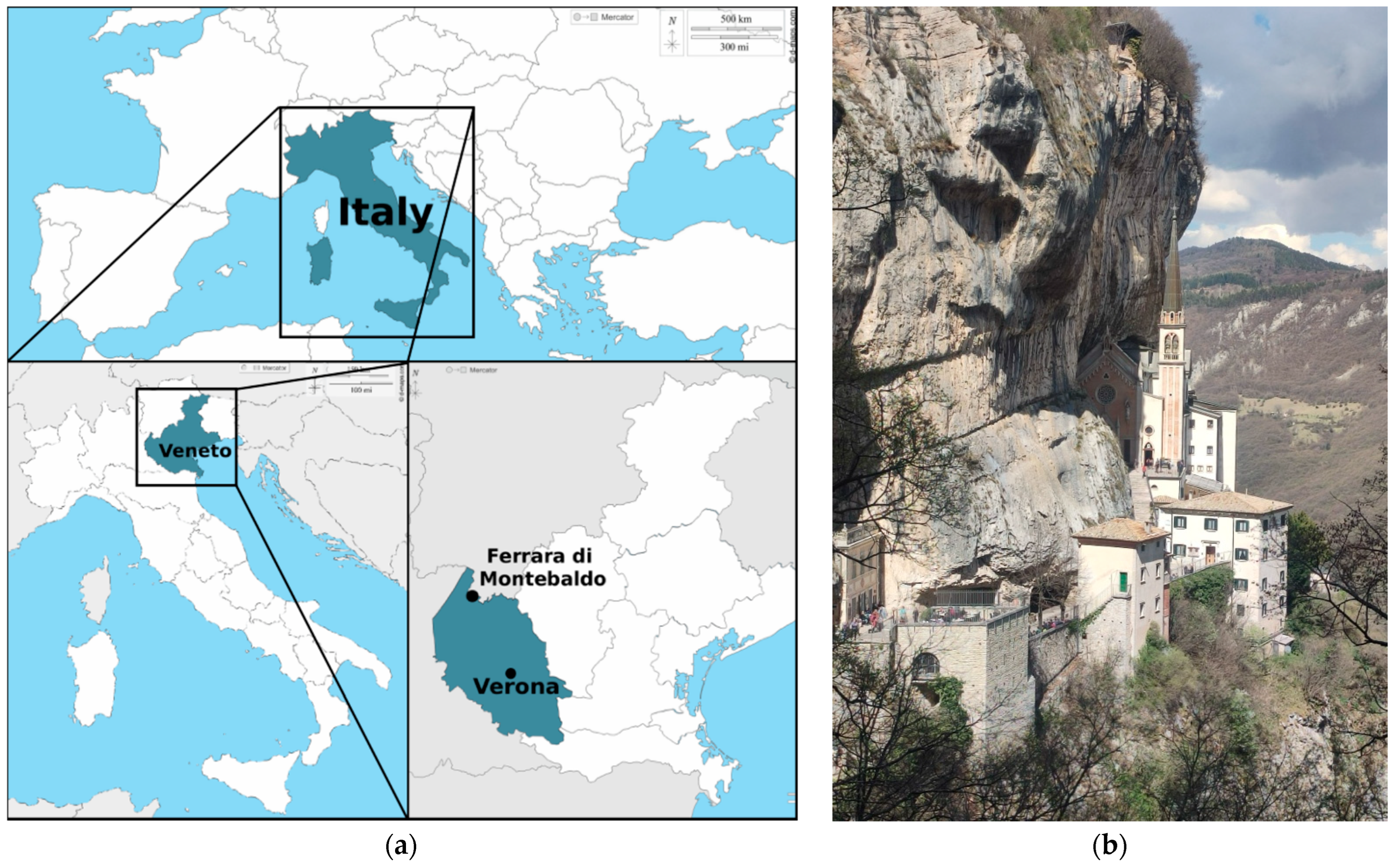
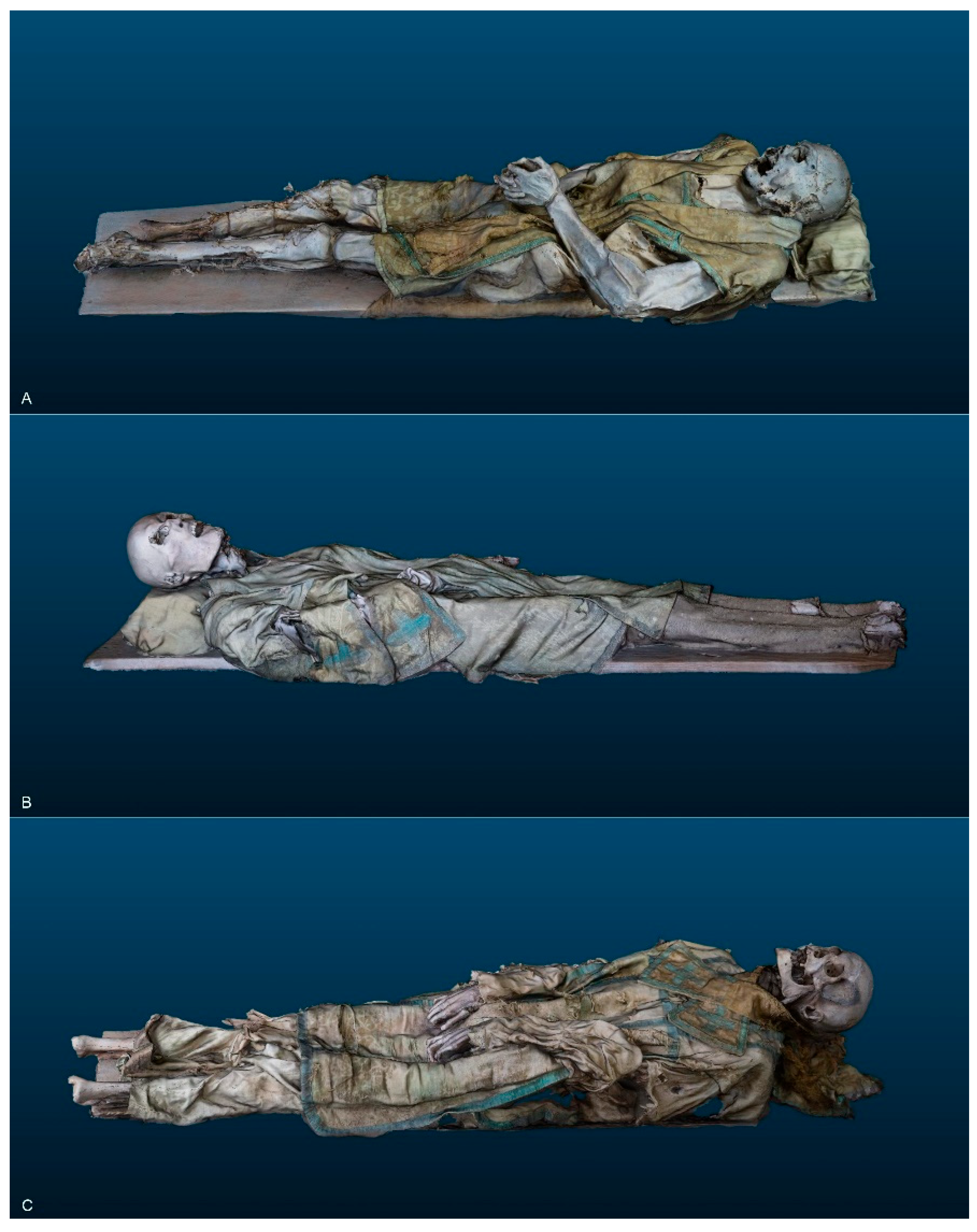
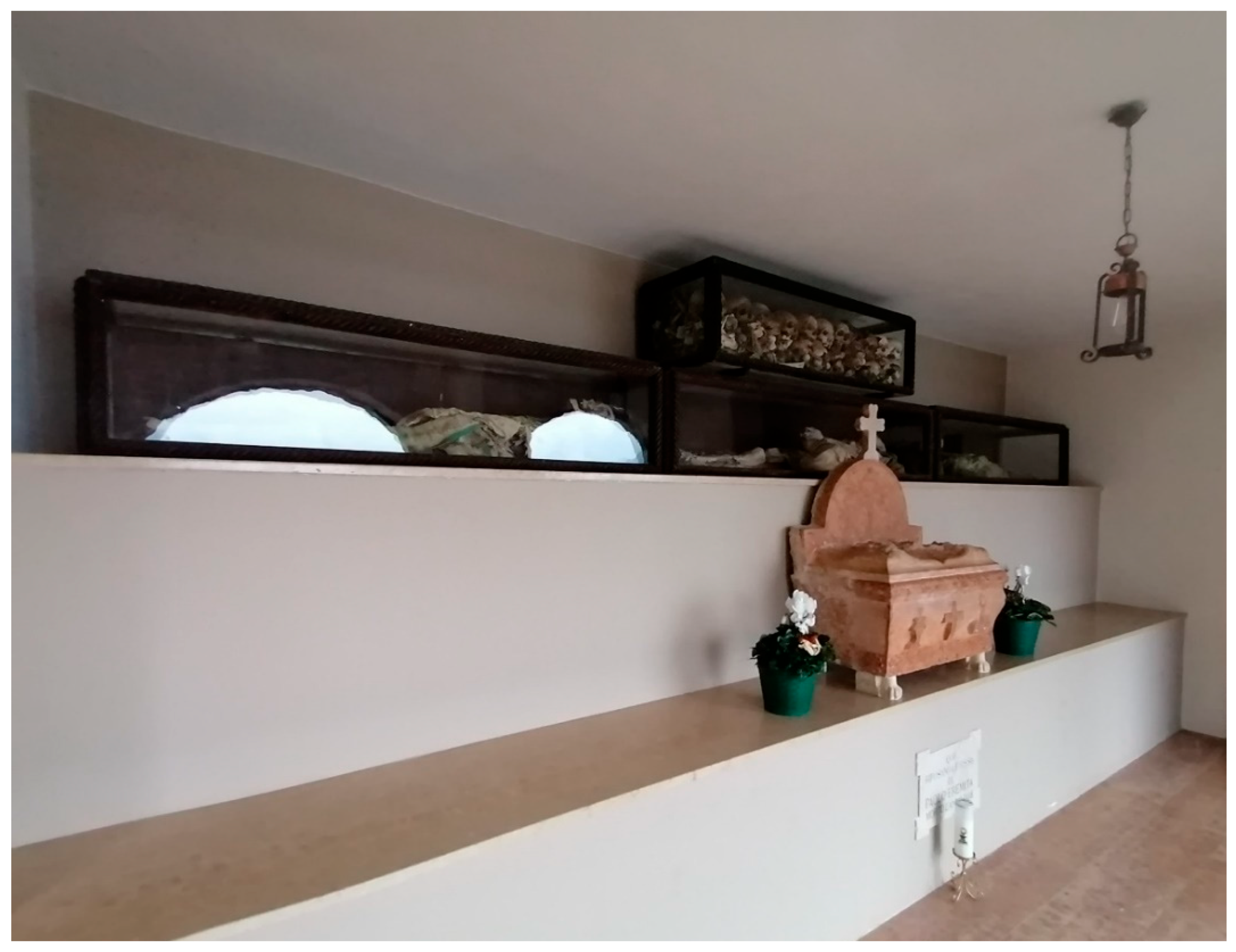
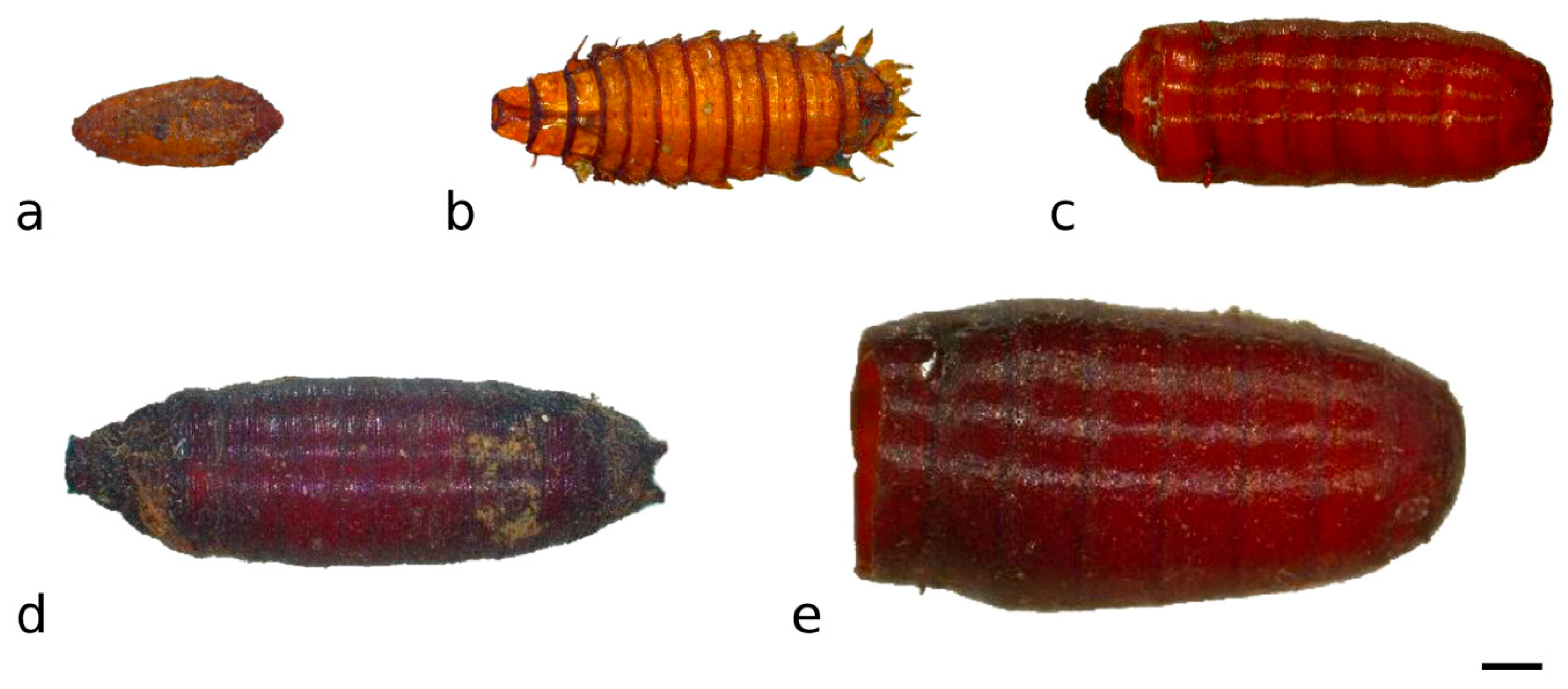
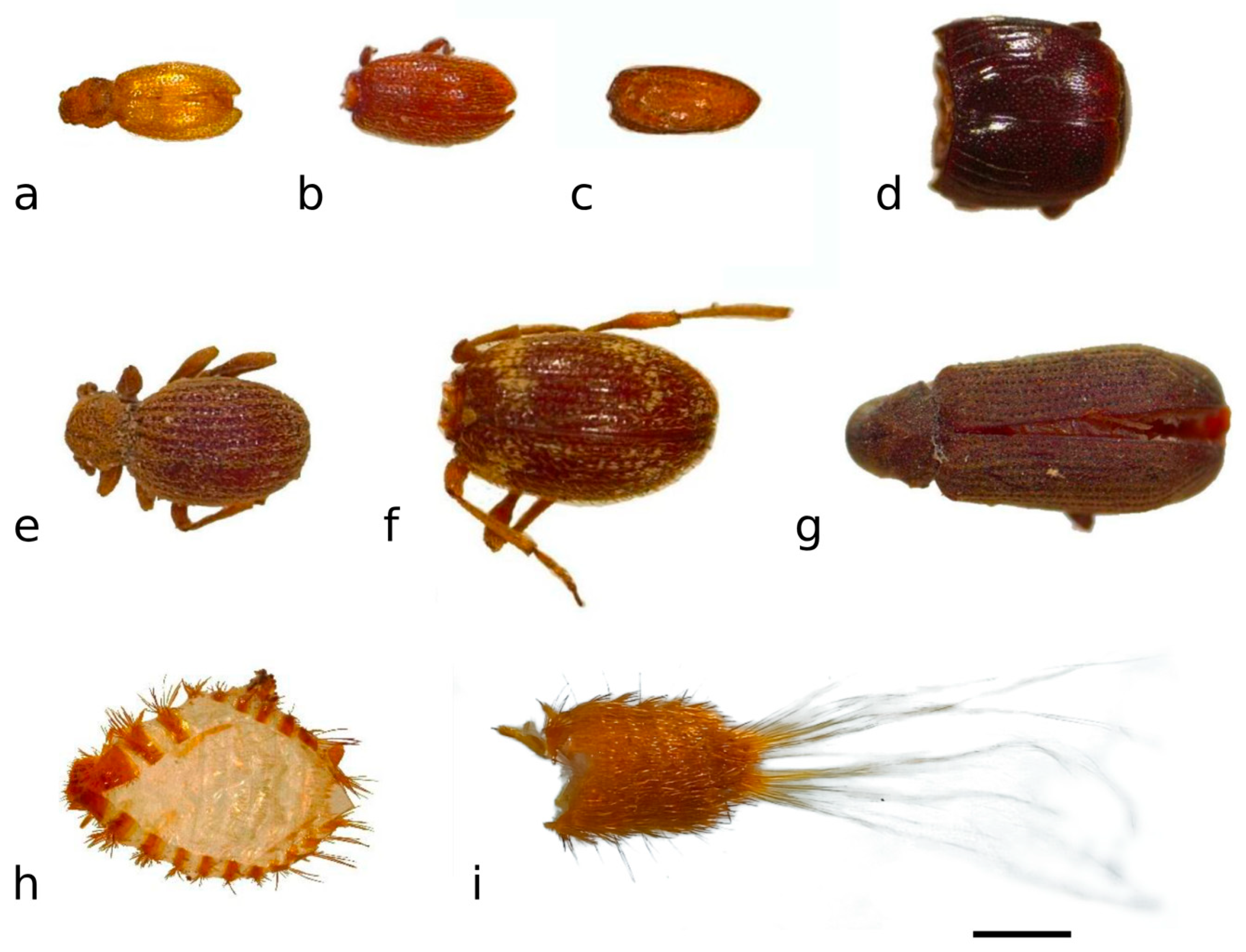

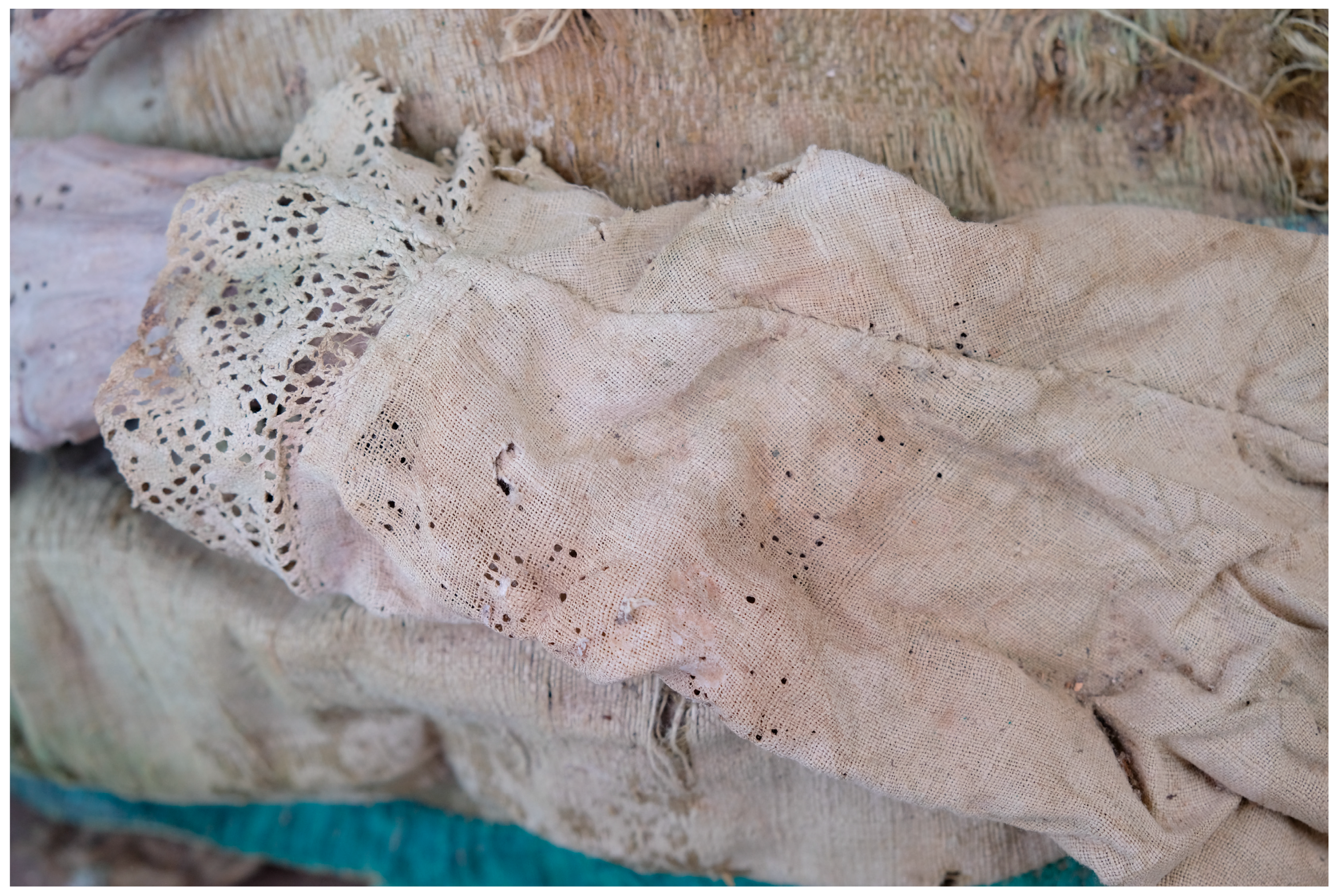

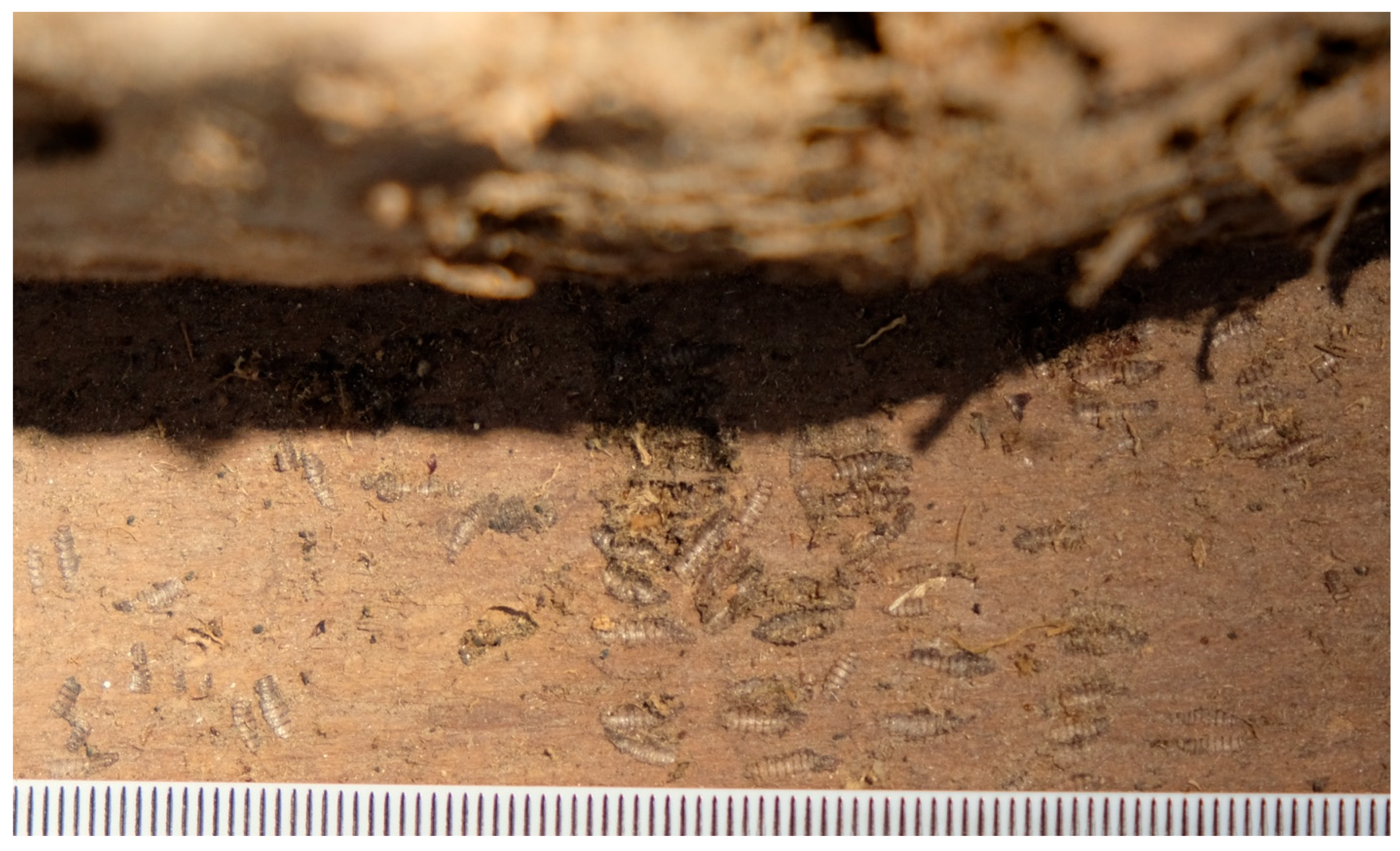
| D. Stage | Individual 1 (18th Cent) | Individual 2 (Mid-17th Cent) | Individual 3 (18th Cent) | ||||
|---|---|---|---|---|---|---|---|
| Arachnida | Aranea | x | |||||
| Acaridida | x | ||||||
| Malacostraca | Isopoda | x | |||||
| Insecta | Coleoptera | Histeridae | Gnathoncus communis | A | x | ||
| Dermestidae | Attagenus sp. | E | x | x | |||
| Anthrenus sp. | E | xxx | xx | xxx | |||
| Ptinidae | Anobium punctatum | A | xxx | x | xxx | ||
| Ptinus fur | A | x | |||||
| Tipnus unicolor | A | xx | |||||
| Cryptophagidae | Cryptophagus sp. | A | x | x | xxx | ||
| Mycetaeidae | Mycetaea subterranea | A | x | ||||
| Latridiidae | Corticaria sp. | A | x | ||||
| Diptera | Phoridae | Gen. sp. | P | xx | x | xxx | |
| Heleomyzidae | Gen. sp. | P | xxxx | ||||
| Fanniidae | Fannia scalaris | P | xxxx | xx | xx | ||
| Muscidae | Hydrotaea capensis | P | xxxx | xx | xxxx | ||
| Calliphoridae | Calliphora vicina | P | xxxx | xxxx | |||
| Lepidoptera | Tineidae | C | xxx | xxx | xxx | ||
| Hymenoptera | A | x |
Disclaimer/Publisher’s Note: The statements, opinions and data contained in all publications are solely those of the individual author(s) and contributor(s) and not of MDPI and/or the editor(s). MDPI and/or the editor(s) disclaim responsibility for any injury to people or property resulting from any ideas, methods, instructions or products referred to in the content. |
© 2025 by the authors. Licensee MDPI, Basel, Switzerland. This article is an open access article distributed under the terms and conditions of the Creative Commons Attribution (CC BY) license (https://creativecommons.org/licenses/by/4.0/).
Share and Cite
Carta, G.; Larentis, O.; Tonina, E.; Gorini, I.; Vanin, S. Entomological Evidence Reveals Burial Practices of Three Mummified Bodies Preserved in Northeast Italy. Heritage 2025, 8, 406. https://doi.org/10.3390/heritage8100406
Carta G, Larentis O, Tonina E, Gorini I, Vanin S. Entomological Evidence Reveals Burial Practices of Three Mummified Bodies Preserved in Northeast Italy. Heritage. 2025; 8(10):406. https://doi.org/10.3390/heritage8100406
Chicago/Turabian StyleCarta, Giuseppina, Omar Larentis, Enrica Tonina, Ilaria Gorini, and Stefano Vanin. 2025. "Entomological Evidence Reveals Burial Practices of Three Mummified Bodies Preserved in Northeast Italy" Heritage 8, no. 10: 406. https://doi.org/10.3390/heritage8100406
APA StyleCarta, G., Larentis, O., Tonina, E., Gorini, I., & Vanin, S. (2025). Entomological Evidence Reveals Burial Practices of Three Mummified Bodies Preserved in Northeast Italy. Heritage, 8(10), 406. https://doi.org/10.3390/heritage8100406





